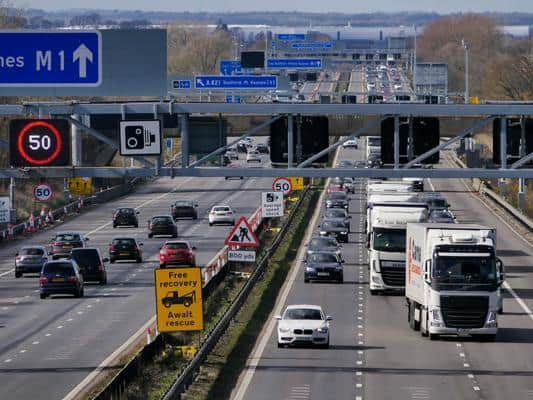'Smart motorway' between Milton Keynes and Luton is causing MORE congestion, data reveals
and live on Freeview channel 276
The multi million pound 'smart motorway running between Milton Keynes and Luton has increased congestion and slowed down journey times, a study has shown.
The junctions 10 to 13 stretch cost £489m to build in 2012 and was designed to improve traffic flow by using the 'dynamic hard shoulder' as an extra lane.
Advertisement
Hide AdAdvertisement
Hide AdRelying upon overhead signs to warn traffic of hazards ahead, the system's benefits were hailed as smoother traffic flow, more reliable journey times, fewer road traffic collisions, and reduced noise and harmful vehicle emissions.


In reality, not only has congestion increased on the stretch but the number of serious injury accidents has also risen.
While figures for accidents with minor injuries have reduced, those with severe injuries increased from an average of six per year to 11 per year.
And more bad news is that the scheme's promised boost to the local economy has not happened. In fact, it is expected to result in a loss of more than £200million over 60 years.
Advertisement
Hide AdAdvertisement
Hide AdThe figures have been revealed by Highways magazine, following their freedom of information request to National Highways, the government company charged with operating, maintaining and improving England's motorways and major roads. The company was formerly known as Highways England.
The magazine requested the release of a previously undisclosed report, which analysed junctions 10 to 13 on the M1 from December 2012 to December 2017.
In the foreword to the report, National Highways executive director Elliot Shaw wrote: ‘The evaluation findings indicate further action is required over the scheme’s 60-year lifecycle for it to meet its appraised value for money objectives."
The report states: "The evaluation observed little change in journey times for road users travelling northbound in the pm peak. For all other time periods, in both directions journey times have increased..."
Advertisement
Hide AdAdvertisement
Hide Ad"To evaluate the monetary impact, we compare the observed journey times against a forecast of the savings then assume the ratio is indicative of the long-term trend to derive the 60-year outturn monetised benefits. Applying this to the observed journey time impacts in the first five years indicates that if the scheme remained on this trajectory the monetised impact on journey times would be -£225m."
The Department for Transport also released the conclusions of the Office of Road and Rail analysis of safety statistics for smart motorways.
AA president Edmund King said: "We are pleased that this further analysis of the performance of smart motorways has been made public. We believe that controlled motorways with a hard-shoulder are the safest option and for other stretches, installing more emergency laybys on the existing network, in our view, will help improve both safety and driver confidence."
He added: "Analysis shows that the forecast benefits have not been realised in some places, resulting in slower journey times, lower speeds and lower levels of economic benefit compared to assumptions."